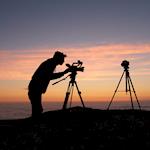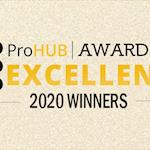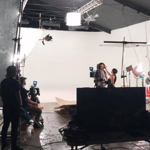We recently conducted a series of interviews to cover some of the production professionals being highlighted and represented at this year's Tribeca Film Festival, which is running from June 8 - 19th.
In this interview, we spoke with Editor Daniel Garber about his work on The Drop.
Synopsis: Lex (PEN15’s Anna Konkle) and Mani (Coming 2 America’s Jermaine Fowler) seem like a happily married couple, running a bakery together and actively trying to have a baby. Their trip to a friend’s destination wedding at a tropical island seems like a great opportunity to keep trying to conceive, all while reconnecting with their successful group of friends. The good vibes are quickly cut short, however, when, upon their arrival at the tropical destination, Lex tries to hold the baby of her friend (Aparna Nancherla, Search Party) who’s getting married, and drops the baby in full view of her friends. This distressing event immediately puts a damper on the nuptial celebrations. Recriminations, passive-aggressive behavior and uncomfortable tension permeates this convening of friends and threatens to further disrupt Lex’s and Mani’s future.
PH: How did you get your start in the film industry and what was your first project?
Daniel Garber: Fresh out of college, I got my start working as a researcher and editor for my former teacher Pacho Velez, who’s an incredible documentary filmmaker. Our work together yielded a series of shorts and then a feature documentary called The Reagan Show, which he co-directed with Sierra Pettengill. The film traces the eight years of Reagan’s presidency through a vast trove of archival footage, revealing how he applied his background as an actor to his greatest role ever: leader of the free world. I managed to make myself essential to the process by understanding better than anyone the thousands of hours of footage we had on hand, but I had virtually no experience and had never cut a feature before. I essentially learned how to be an editor from my fellow editors on that project, Francisco Bello and David Barker; I don’t know where I’d be without them.
PH: What project did you work on at Tribeca and how did you become involved?
Daniel Garber: I edited The Drop, alongside its writer-director Sarah Adina Smith. For her first two features, Sarah was her own editor: she’s very comfortable with Premiere and adept as an editor. After directing an Amazon film called Birds of Paradise, she returned to her indie roots on The Drop. She needed to find an editor who was willing to work without an assistant editor, game to travel to Mexico for the shoot, open to sharing editing responsibilities with her, and excited by the idea of working on an improvised film with loads of footage. I fit the bill, partly because of my experience with documentary editing, which is often a very scrappy affair and involves tons of footage. My mentor David Barker recommended me for the job, and Sarah and I hit it off.
PH: Why did you choose to edit on Premiere Pro and how did it help you achieve the creative vision?
Daniel Garber: The decision to work on Premiere Pro was a no-brainer. At the very beginning, Sarah and I were relieved to find that we were both Premiere fans. In the past, we’ve both had to work in Avid at the behest of studios or networks, but this time we had nobody to tell us we couldn’t cut in our favorite NLE. It’s easy to name the concrete advantages that Premiere has over the alternatives, like how easily it integrates with other Adobe Creative Cloud software like Audition, After Effects, and Photoshop, as well as Frame.io. It’s very versatile and forgiving when you work on the same project on various systems, which was important to us because I had to cut on a laptop on set, and after the shoot, Sarah and I worked remotely through most of post—she on the West Coast in the Duplass offices; I on the East, in my home office. And with the addition of the Productions feature, Premiere was incredibly stable and made collaboration easy.
Above all, Premiere Pro just makes me faster. I find that it shrinks the distance between my ideas and the timeline. All of that is hugely beneficial to the process, because it makes it so much easier to experiment if we don’t have to constantly wonder “how long is this going to take? Do we have time to try this?” It helped Sarah and me to make the most use of our limited time in the room together.
PH: What was your favorite scene to cut together and why?
Daniel Garber: As an editor, one of my favorite sequences to tackle was a boat trip that our characters take about halfway through the film. Already they have left their ordinary urban surroundings and the comforts of home for a rustic retreat somewhere in Mexico by the ocean; they’ve endured the shock of Lex, one of our main characters, dropping her friend’s baby, sowing tension and recriminations among the ensemble; and now they’re all stuck on a boat together with nowhere to go. The characters split into smaller groups, and the sequence traces the conversations of each of these smaller groups as the discomfort for our main characters Mani and Lex continues to grow.
With a cast of skilled improvisers, we had an embarrassment of riches: each take was hilarious, distinct, and ran way longer than necessary. The vignettes with each set of characters were covered very simply, often with only one or two shots per scene, and these improvised conversations often ran very long—so it was a challenge to build a sequence that kept all of the comedic value of the source footage while drastically reducing it even with our limited coverage. But ultimately, that was one of the sequence’s greatest strengths: by intercutting the different storylines, we opened new avenues for comedy by juxtaposing the different characters’ dialogue and using cuts as punctuation for already funny performance moments. Ping-ponging across the different conversations creates a kind of momentum through that part of the story, while creating a sense of the group as a whole and the kinds of tensions and resentments that are beginning to surface. That section became what I think is one of the most entertaining parts of the entire film—with the actors’ top-notch improvisation and Sarah’s and my editing working hand-in-hand to build an extended sequence of cringe comedy.
PH: How did you collaborate with others involved in the post-production process (assistant editor, directors, producers, etc)?
Daniel Garber: The post-production team was quite small on this project. We didn’t even have an assistant editor; it was just Sarah, our fantastic post-production supervisor Alex Regalado, and me. Between the pandemic, living on opposite coasts, and Sarah having a baby in the middle of the editing process, this was always planned to be a remote-first workflow. Aside from the few weeks we spent on set together and a concentrated stint of a few weeks working together out of the Duplass Brothers Productions’ offices in Los Angeles, we weren’t in the same space.
Sarah and I love being in the room and hashing things out face to face. But three tools made the collaboration easy, despite the less-than-ideal circumstances: Premiere Pro’s Productions feature was a real lifesaver for us. We had mirrored drives and exchanged updated projects over Dropbox, so we could be up to date on one another’s work. We could easily leave markers in our sequences to say, “hey, look at this change and tell me what you think.” We also made heavy use of Frame.io to share scenes and full cuts of the film with each other and with our producers. And finally, I rigged up a setup that basically functioned like a bootleg Evercast, where I used Premiere’s Mercury Transmit to stream the video feed directly into a capture device, which was hooked up to Zoom. That way, Sarah was able to work with me in realtime, as if we were in the room together.
PH: What is one thing you wish you would have known first starting out in the film industry?
Daniel Garber: Everyone told me that this business is partially about building relationships—“it’s who you know.” That’s true, but I never quite realized how much the relationship-building has to do with the work itself. How well you get along with your collaborators can so thoroughly determine your enjoyment of the process and the quality of the final film, so it’s important to cherish and invest in relationships with people you genuinely admire. You can’t take them for granted. I’m still pretty early in my career, but I’ve been through this enough times to know just how lucky I’ve been to have excellent teammates in the process of making The Drop.
PH: What is the best piece of advice you’ve ever received?
Daniel Garber: Cut from your gut.












Comments
There are no comments on this blog post.